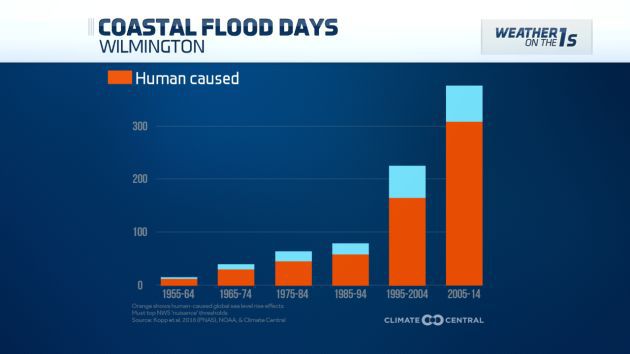A study released last week by the National Oceanic and Atmospheric Administration (NOAA) shows a record number of days with "nuisance" flooding in Wilmington over the last year. The report looked at the number of days from May 2015 through April 2016 when water levels measured by tidal gauges reached above NOAA's threshold for minor impacts. There were 90 days in that one year period where this type of flooding was recorded in Wilmington. This nuisance flooding is sometimes also referred to as "clear sky" flooding as it not the result of rain. Higher than normal tides cause rising waters along the Cape Fear River in these flood events. This typically results in water along portions of Water Street and along some roads and parking lots near the USS North Carolina.
Wilmington saw far more days with this type of coastal flooding than other U.S. cities that also set records. Some of the other record setting cities included Charleston, South Carolina with 38 days, Port Isabel, Florida with 36 days, and near Jacksonville, Florida with 19 days.
The increase in tidal flooding in Wilmington over the last year is likely at least partly due to El Niño. This global weather pattern can affect various weather conditions around the planet. Research has shown an increase in tidal flooding along the Mid-Atlantic coast during an El Niño year.
However, there is also a trend in more coastal flood days in recent years that still occurs even in non-El Niño years. A 2016 analysis by Climate Central suggests there is a human influence in the rise of coastal flooding in the United States. Climate Central is an independent group of researchers that studies climate change and its impacts on the public.
The Climate Central study found that at least two-thirds of coastal flood days can be attributed to human induced sea level rise. In Wilmington, 77-percent of coastal flood days were attributed to sea level rise.

Prior studies from various climate researchers have shown global sea level rise is linked to climate change. It is widely accepted among climate researchers that an increase in greenhouse gas emissions like carbon dioxide is leading to a warming planet. The warming of seawater causes oceans to expand and ice near the Arctic to melt. The end result is a rising sea level that is expected to continue as greenhouse gas emissions continue to rise.
- Click here to read to NOAA's nuisance flooding study
- Click here to read the full study on climate change and sea level rise from Climate Central





